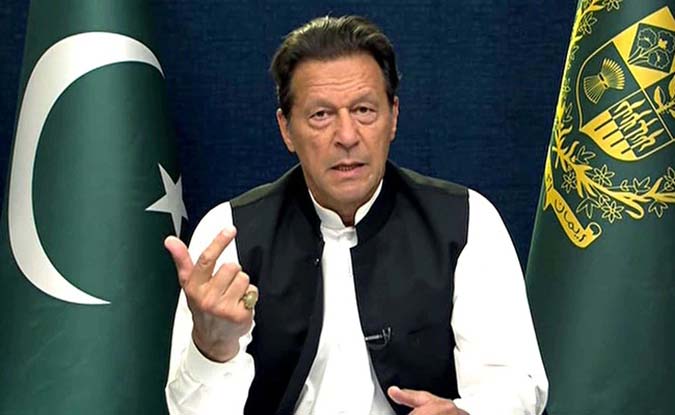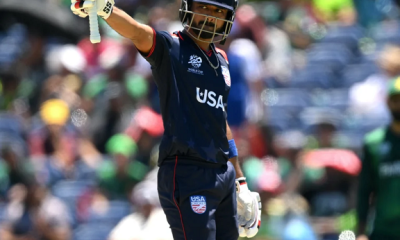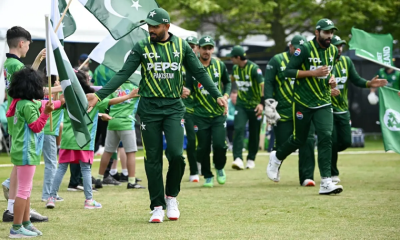Features
Pakistan and Imran Khan

 The recent elections in Pakistan have been followed by me as similarities are marked between that country and ours. Imran Khan has long been a much admired and respected person about whom I have read much.
The recent elections in Pakistan have been followed by me as similarities are marked between that country and ours. Imran Khan has long been a much admired and respected person about whom I have read much.
As I write this article on Thursday February 15, it looks as if there has been no great system change in the country though voters definitely voted for such, giving the highest number of votes to those who presented themselves as independent candidates but were of Imran Khan’s political party – Tehreek-e-Insaf or P.T.I.
A decision has been made to form a coalition government approved by the military of Nawaz Sharif’s PML-N and the PPI led by Asif Ali Zardari and his son Bilawal Bhutto Zardari, son of Benazir Bhutto. The Prime Minister will be Nawaz Sharif’s younger brother Shehbaz Sharif, not Bilawal Zardari 35, Chair of the PPP at 17 when his mother died and recently Minister of Foreign Affairs. The probable PM is a rich businessman dealing in steel.
Loyalists of Khan, like him, are strongly against the army and thus the jubilation at having won most seats – 91 against the PML-N’s 76 and PPP’s 54 of a total of 265 parliamentary seats. Military power seems to have prevailed again and will not give in easily to a more democratic government. P.T.I, loyalists have accused the army of massive vote rigging. Thus either Khan and his wife will remain in prison and have to serve their terms or chaos will result.
One never knows how the situation will be in Pakistan come Sunday February 18 when you read this column. (References: Imran Khan’s opponents reach deal to shut his allies out of government by Salman Masood and Christina Goldbaum, and other articles in the NYT of February 14)
Social media plays role
It is now well known that when Pakistan’s before-elections government censored media, Imran Khan’s party posted campaign videos on TikTok, and when their party rallies were banned, they hosted virtual gatherings with speeches by Imran Khan behind bars, simulated and broadcast using artificial intelligence. The county’s generals fell out with Khan as PM, who refused to be dictated to by the all-powerful army, and was ousted from Parliament in 2022. Authorities brought more than a dozen charges against Khan and imprisoned him.
One accusation was that he released state classified information. He and his wife, religious Bibi were imprisoned. The Elections Commission stated that the P.T.I had not been properly registered and thus banned candidates of the party with its symbol of a cricket bat, from contesting. Thus the large number of independent candidates of the P.T.I. who won in the February 8 elections.
Comparison
The obvious dissimilarities between Pakistan and Sri Lanka are size and population. To Pakistan’s population of 240m ours is 22; a glance at a map shows how small our land is compared to Pakistan. We are overall a more literate and educated populace of a more secular country with women not controlled or heavily discriminated against.
The most significant is that Pakistan has for most of its existence been under the military either directly or indirectly with even fairly democratically governments controlled by the military. It has gone through several military coups; our history registers but one failed – that of 1962 against Mrs Bandaranaike’s government – planned by a few military and police high ups. Pakistan is a nuclear power.
The greatest dissimilarity is that while Imran Khan rose to lead his country to a more democratic nation in truly heroic fashion, we have lacked since the earliest leaders like DS, Dudley and Kotelawela, any really great leader who puts country before self. Khan has been pronounced to be “A reformer who would bring change.
” “Mr Khan’s message resonated with millions across the country who were frustrated by the country’s economic crisis and old political dynasties… and only he could restore its former greatness.” He emerges a genuine, committed politician concerned first and last about his country and his people. One point here: Khan could have lived anywhere in the world in luxury and comfort but he decided to stay in Pakistan,
enter politics and lead the country to greater democracy, concerned about the poor and disadvantaged. He sacrificed a happy family life for the sake of his country; Jemima Goldsmith, his millionairess British wife, found extended family life in Pakistan stifling and wanted to return to England. Imran wanted to stay back. Hence their divorce and break up of family.
The Man
Imran Ahmad Khan Niazi was born in Lahore on October 5, 1952 to a wealthy upper middle class family of Pashtun descent of the Niazi tribe. His father was a civil engineer. Both on his paternal and maternal sides were distinguished ancestors. He attended a prestigious school in Lahore then Royal Green School, Worcester, and graduated from Keble College, Oxford University in 1975. He continued his cricket playing encouraged at school in Worcester until 1992, captaining the Pakistan team to win the World Cup that year.
As a very handsome, personable young man, flashy even, he was dubbed ‘hedonistic bachelor’ or in plain language, a playboy. He was just that, very evident in British high society, dating several film starlets and others; even accused of paternity which he denied. He married heiress Jemima Goldsmith in 1995, and she converted to Islam. By then he was drawn back to his country of birth and she moved with him, changing her style of dress and attempting to integrate to his family. They had two sons: Sulaiman Isa and Kasim. In 2004 they divorced very amicably with Jemima taking the two children back to England. Reason given: “Difficult for Jemima to adapt to life in Pakistan.”
By now Imran was fully into politics; opposed to military rule and sincerely concerned about country and his people. What makes me admire the man unreservedly is his devotion to his mother Shaukat Khannan who succumbed to cancer in 1985. Visiting her in hospital, he noticed how relatives of patients loitered around with no restrooms and other facilities.
He decided to build a cancer hospital with free service and accommodation for patients’ near relatives to stay over too. He invested his money and also wrote to friends. Contributions poured in. He built a cancer hospital in Lahore and a second one in Peshawar of the highest standard and created the Shaukat Khannan Memorial Trust which has set up cancer detecting and treating centres nationwide with international support of famous persons.
In January 2015 he contracted a disastrous marriage with beautiful British–Pakistani journalist Reham Khan who was a weather announcer on BBC. The marriage lasted less than a year – till October – and saw scorned Reham wreaking vengeance by writing her autobiography with very damaging chapters about Khan just prior to the 2018 elections which he contested, under his newly created Party which won most seats. Joining up with smaller parties he formed the government. Khan served as PM from August 2018 to April 2022 when the military maneuvered his ouster.
In 2016 to early 2018 reports emerged that Khan had married his spiritual mentor Bushra Bibi Manika, which were denied. In 2018 the PTI confirmed the marriage had taken place. His pet dogs, I read, proved to be a bone of contention as the bride was averse to dogs, so his were sent to his estate.
Comment
I listed some similarities and differences that exist between the status quo of Pakistan and that of Sri Lanka. Most people of both countries are disappointed in their leaders and government while in Pakistan there is severe criticism of the military interfering with politics and ruling de facto. We are free of this imposition. Political dynasties still hold sway in Pakistan judging by the leaders of the new formed coalition government; which curse is diminishing in Sri Lanka.
Many more miseries attend both nations like economic downfall. However, Pakistan has a potential statesman, now imprisoned, but having support of the majority of the population, judging by election results. Sri Lanka is woefully short of such a person. There are national minded, honest persons in the wings ready to serve the country and not oneself; but still unidentified. Thus what hope is possible?
Features
The heart-friendly health minister

by Dr Gotabhya Ranasinghe
Senior Consultant Cardiologist
National Hospital Sri Lanka
When we sought a meeting with Hon Dr. Ramesh Pathirana, Minister of Health, he graciously cleared his busy schedule to accommodate us. Renowned for his attentive listening and deep understanding, Minister Pathirana is dedicated to advancing the health sector. His openness and transparency exemplify the qualities of an exemplary politician and minister.
Dr. Palitha Mahipala, the current Health Secretary, demonstrates both commendable enthusiasm and unwavering support. This combination of attributes makes him a highly compatible colleague for the esteemed Minister of Health.
Our discussion centered on a project that has been in the works for the past 30 years, one that no other minister had managed to advance.
Minister Pathirana, however, recognized the project’s significance and its potential to revolutionize care for heart patients.
The project involves the construction of a state-of-the-art facility at the premises of the National Hospital Colombo. The project’s location within the premises of the National Hospital underscores its importance and relevance to the healthcare infrastructure of the nation.
This facility will include a cardiology building and a tertiary care center, equipped with the latest technology to handle and treat all types of heart-related conditions and surgeries.
Securing funding was a major milestone for this initiative. Minister Pathirana successfully obtained approval for a $40 billion loan from the Asian Development Bank. With the funding in place, the foundation stone is scheduled to be laid in September this year, and construction will begin in January 2025.
This project guarantees a consistent and uninterrupted supply of stents and related medications for heart patients. As a result, patients will have timely access to essential medical supplies during their treatment and recovery. By securing these critical resources, the project aims to enhance patient outcomes, minimize treatment delays, and maintain the highest standards of cardiac care.
Upon its fruition, this monumental building will serve as a beacon of hope and healing, symbolizing the unwavering dedication to improving patient outcomes and fostering a healthier society.We anticipate a future marked by significant progress and positive outcomes in Sri Lanka’s cardiovascular treatment landscape within the foreseeable timeframe.
Features
A LOVING TRIBUTE TO JESUIT FR. ALOYSIUS PIERIS ON HIS 90th BIRTHDAY

by Fr. Emmanuel Fernando, OMI
Jesuit Fr. Aloysius Pieris (affectionately called Fr. Aloy) celebrated his 90th birthday on April 9, 2024 and I, as the editor of our Oblate Journal, THE MISSIONARY OBLATE had gone to press by that time. Immediately I decided to publish an article, appreciating the untiring selfless services he continues to offer for inter-Faith dialogue, the renewal of the Catholic Church, his concern for the poor and the suffering Sri Lankan masses and to me, the present writer.
It was in 1988, when I was appointed Director of the Oblate Scholastics at Ampitiya by the then Oblate Provincial Fr. Anselm Silva, that I came to know Fr. Aloy more closely. Knowing well his expertise in matters spiritual, theological, Indological and pastoral, and with the collaborative spirit of my companion-formators, our Oblate Scholastics were sent to Tulana, the Research and Encounter Centre, Kelaniya, of which he is the Founder-Director, for ‘exposure-programmes’ on matters spiritual, biblical, theological and pastoral. Some of these dimensions according to my view and that of my companion-formators, were not available at the National Seminary, Ampitiya.
Ever since that time, our Oblate formators/ accompaniers at the Oblate Scholasticate, Ampitiya , have continued to send our Oblate Scholastics to Tulana Centre for deepening their insights and convictions regarding matters needed to serve the people in today’s context. Fr. Aloy also had tried very enthusiastically with the Oblate team headed by Frs. Oswald Firth and Clement Waidyasekara to begin a Theologate, directed by the Religious Congregations in Sri Lanka, for the contextual formation/ accompaniment of their members. It should very well be a desired goal of the Leaders / Provincials of the Religious Congregations.
Besides being a formator/accompanier at the Oblate Scholasticate, I was entrusted also with the task of editing and publishing our Oblate journal, ‘The Missionary Oblate’. To maintain the quality of the journal I continue to depend on Fr. Aloy for his thought-provoking and stimulating articles on Biblical Spirituality, Biblical Theology and Ecclesiology. I am very grateful to him for his generous assistance. Of late, his writings on renewal of the Church, initiated by Pope St. John XX111 and continued by Pope Francis through the Synodal path, published in our Oblate journal, enable our readers to focus their attention also on the needed renewal in the Catholic Church in Sri Lanka. Fr. Aloy appreciated very much the Synodal path adopted by the Jesuit Pope Francis for the renewal of the Church, rooted very much on prayerful discernment. In my Religious and presbyteral life, Fr.Aloy continues to be my spiritual animator / guide and ongoing formator / acccompanier.
Fr. Aloysius Pieris, BA Hons (Lond), LPh (SHC, India), STL (PFT, Naples), PhD (SLU/VC), ThD (Tilburg), D.Ltt (KU), has been one of the eminent Asian theologians well recognized internationally and one who has lectured and held visiting chairs in many universities both in the West and in the East. Many members of Religious Congregations from Asian countries have benefited from his lectures and guidance in the East Asian Pastoral Institute (EAPI) in Manila, Philippines. He had been a Theologian consulted by the Federation of Asian Bishops’ Conferences for many years. During his professorship at the Gregorian University in Rome, he was called to be a member of a special group of advisers on other religions consulted by Pope Paul VI.
Fr. Aloy is the author of more than 30 books and well over 500 Research Papers. Some of his books and articles have been translated and published in several countries. Among those books, one can find the following: 1) The Genesis of an Asian Theology of Liberation (An Autobiographical Excursus on the Art of Theologising in Asia, 2) An Asian Theology of Liberation, 3) Providential Timeliness of Vatican 11 (a long-overdue halt to a scandalous millennium, 4) Give Vatican 11 a chance, 5) Leadership in the Church, 6) Relishing our faith in working for justice (Themes for study and discussion), 7) A Message meant mainly, not exclusively for Jesuits (Background information necessary for helping Francis renew the Church), 8) Lent in Lanka (Reflections and Resolutions, 9) Love meets wisdom (A Christian Experience of Buddhism, 10) Fire and Water 11) God’s Reign for God’s poor, 12) Our Unhiddden Agenda (How we Jesuits work, pray and form our men). He is also the Editor of two journals, Vagdevi, Journal of Religious Reflection and Dialogue, New Series.
Fr. Aloy has a BA in Pali and Sanskrit from the University of London and a Ph.D in Buddhist Philosophy from the University of Sri Lankan, Vidyodaya Campus. On Nov. 23, 2019, he was awarded the prestigious honorary Doctorate of Literature (D.Litt) by the Chancellor of the University of Kelaniya, the Most Venerable Welamitiyawe Dharmakirthi Sri Kusala Dhamma Thera.
Fr. Aloy continues to be a promoter of Gospel values and virtues. Justice as a constitutive dimension of love and social concern for the downtrodden masses are very much noted in his life and work. He had very much appreciated the commitment of the late Fr. Joseph (Joe) Fernando, the National Director of the Social and Economic Centre (SEDEC) for the poor.
In Sri Lanka, a few religious Congregations – the Good Shepherd Sisters, the Christian Brothers, the Marist Brothers and the Oblates – have invited him to animate their members especially during their Provincial Congresses, Chapters and International Conferences. The mainline Christian Churches also have sought his advice and followed his seminars. I, for one, regret very much, that the Sri Lankan authorities of the Catholic Church –today’s Hierarchy—- have not sought Fr.
Aloy’s expertise for the renewal of the Catholic Church in Sri Lanka and thus have not benefited from the immense store of wisdom and insight that he can offer to our local Church while the Sri Lankan bishops who governed the Catholic church in the immediate aftermath of the Second Vatican Council (Edmund Fernando OMI, Anthony de Saram, Leo Nanayakkara OSB, Frank Marcus Fernando, Paul Perera,) visited him and consulted him on many matters. Among the Tamil Bishops, Bishop Rayappu Joseph was keeping close contact with him and Bishop J. Deogupillai hosted him and his team visiting him after the horrible Black July massacre of Tamils.
Features
A fairy tale, success or debacle

Sri Lanka-Singapore Free Trade Agreement
By Gomi Senadhira
senadhiragomi@gmail.com
“You might tell fairy tales, but the progress of a country cannot be achieved through such narratives. A country cannot be developed by making false promises. The country moved backward because of the electoral promises made by political parties throughout time. We have witnessed that the ultimate result of this is the country becoming bankrupt. Unfortunately, many segments of the population have not come to realize this yet.” – President Ranil Wickremesinghe, 2024 Budget speech
Any Sri Lankan would agree with the above words of President Wickremesinghe on the false promises our politicians and officials make and the fairy tales they narrate which bankrupted this country. So, to understand this, let’s look at one such fairy tale with lots of false promises; Ranil Wickremesinghe’s greatest achievement in the area of international trade and investment promotion during the Yahapalana period, Sri Lanka-Singapore Free Trade Agreement (SLSFTA).
It is appropriate and timely to do it now as Finance Minister Wickremesinghe has just presented to parliament a bill on the National Policy on Economic Transformation which includes the establishment of an Office for International Trade and the Sri Lanka Institute of Economics and International Trade.
Was SLSFTA a “Cleverly negotiated Free Trade Agreement” as stated by the (former) Minister of Development Strategies and International Trade Malik Samarawickrama during the Parliamentary Debate on the SLSFTA in July 2018, or a colossal blunder covered up with lies, false promises, and fairy tales? After SLSFTA was signed there were a number of fairy tales published on this agreement by the Ministry of Development Strategies and International, Institute of Policy Studies, and others.
However, for this article, I would like to limit my comments to the speech by Minister Samarawickrama during the Parliamentary Debate, and the two most important areas in the agreement which were covered up with lies, fairy tales, and false promises, namely: revenue loss for Sri Lanka and Investment from Singapore. On the other important area, “Waste products dumping” I do not want to comment here as I have written extensively on the issue.
1. The revenue loss
During the Parliamentary Debate in July 2018, Minister Samarawickrama stated “…. let me reiterate that this FTA with Singapore has been very cleverly negotiated by us…. The liberalisation programme under this FTA has been carefully designed to have the least impact on domestic industry and revenue collection. We have included all revenue sensitive items in the negative list of items which will not be subject to removal of tariff. Therefore, 97.8% revenue from Customs duty is protected. Our tariff liberalisation will take place over a period of 12-15 years! In fact, the revenue earned through tariffs on goods imported from Singapore last year was Rs. 35 billion.
The revenue loss for over the next 15 years due to the FTA is only Rs. 733 million– which when annualised, on average, is just Rs. 51 million. That is just 0.14% per year! So anyone who claims the Singapore FTA causes revenue loss to the Government cannot do basic arithmetic! Mr. Speaker, in conclusion, I call on my fellow members of this House – don’t mislead the public with baseless criticism that is not grounded in facts. Don’t look at petty politics and use these issues for your own political survival.”
I was surprised to read the minister’s speech because an article published in January 2018 in “The Straits Times“, based on information released by the Singaporean Negotiators stated, “…. With the FTA, tariff savings for Singapore exports are estimated to hit $10 million annually“.
As the annual tariff savings (that is the revenue loss for Sri Lanka) calculated by the Singaporean Negotiators, Singaporean $ 10 million (Sri Lankan rupees 1,200 million in 2018) was way above the rupees’ 733 million revenue loss for 15 years estimated by the Sri Lankan negotiators, it was clear to any observer that one of the parties to the agreement had not done the basic arithmetic!
Six years later, according to a report published by “The Morning” newspaper, speaking at the Committee on Public Finance (COPF) on 7th May 2024, Mr Samarawickrama’s chief trade negotiator K.J. Weerasinghehad had admitted “…. that forecasted revenue loss for the Government of Sri Lanka through the Singapore FTA is Rs. 450 million in 2023 and Rs. 1.3 billion in 2024.”
If these numbers are correct, as tariff liberalisation under the SLSFTA has just started, we will pass Rs 2 billion very soon. Then, the question is how Sri Lanka’s trade negotiators made such a colossal blunder. Didn’t they do their basic arithmetic? If they didn’t know how to do basic arithmetic they should have at least done their basic readings. For example, the headline of the article published in The Straits Times in January 2018 was “Singapore, Sri Lanka sign FTA, annual savings of $10m expected”.
Anyway, as Sri Lanka’s chief negotiator reiterated at the COPF meeting that “…. since 99% of the tariffs in Singapore have zero rates of duty, Sri Lanka has agreed on 80% tariff liberalisation over a period of 15 years while expecting Singapore investments to address the imbalance in trade,” let’s turn towards investment.
Investment from Singapore
In July 2018, speaking during the Parliamentary Debate on the FTA this is what Minister Malik Samarawickrama stated on investment from Singapore, “Already, thanks to this FTA, in just the past two-and-a-half months since the agreement came into effect we have received a proposal from Singapore for investment amounting to $ 14.8 billion in an oil refinery for export of petroleum products. In addition, we have proposals for a steel manufacturing plant for exports ($ 1 billion investment), flour milling plant ($ 50 million), sugar refinery ($ 200 million). This adds up to more than $ 16.05 billion in the pipeline on these projects alone.
And all of these projects will create thousands of more jobs for our people. In principle approval has already been granted by the BOI and the investors are awaiting the release of land the environmental approvals to commence the project.
I request the Opposition and those with vested interests to change their narrow-minded thinking and join us to develop our country. We must always look at what is best for the whole community, not just the few who may oppose. We owe it to our people to courageously take decisions that will change their lives for the better.”
According to the media report I quoted earlier, speaking at the Committee on Public Finance (COPF) Chief Negotiator Weerasinghe has admitted that Sri Lanka was not happy with overall Singapore investments that have come in the past few years in return for the trade liberalisation under the Singapore-Sri Lanka Free Trade Agreement. He has added that between 2021 and 2023 the total investment from Singapore had been around $162 million!
What happened to those projects worth $16 billion negotiated, thanks to the SLSFTA, in just the two-and-a-half months after the agreement came into effect and approved by the BOI? I do not know about the steel manufacturing plant for exports ($ 1 billion investment), flour milling plant ($ 50 million) and sugar refinery ($ 200 million).
However, story of the multibillion-dollar investment in the Petroleum Refinery unfolded in a manner that would qualify it as the best fairy tale with false promises presented by our politicians and the officials, prior to 2019 elections.
Though many Sri Lankans got to know, through the media which repeatedly highlighted a plethora of issues surrounding the project and the questionable credentials of the Singaporean investor, the construction work on the Mirrijiwela Oil Refinery along with the cement factory began on the24th of March 2019 with a bang and Minister Ranil Wickremesinghe and his ministers along with the foreign and local dignitaries laid the foundation stones.
That was few months before the 2019 Presidential elections. Inaugurating the construction work Prime Minister Ranil Wickremesinghe said the projects will create thousands of job opportunities in the area and surrounding districts.
The oil refinery, which was to be built over 200 acres of land, with the capacity to refine 200,000 barrels of crude oil per day, was to generate US$7 billion of exports and create 1,500 direct and 3,000 indirect jobs. The construction of the refinery was to be completed in 44 months. Four years later, in August 2023 the Cabinet of Ministers approved the proposal presented by President Ranil Wickremesinghe to cancel the agreement with the investors of the refinery as the project has not been implemented! Can they explain to the country how much money was wasted to produce that fairy tale?
It is obvious that the President, ministers, and officials had made huge blunders and had deliberately misled the public and the parliament on the revenue loss and potential investment from SLSFTA with fairy tales and false promises.
As the president himself said, a country cannot be developed by making false promises or with fairy tales and these false promises and fairy tales had bankrupted the country. “Unfortunately, many segments of the population have not come to realize this yet”.
(The writer, a specialist and an activist on trade and development issues . )
























